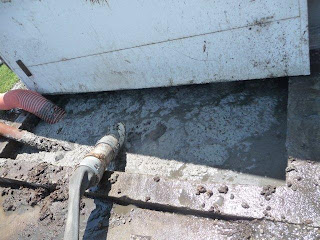A quick re-cap of some key points about the Pump Curves:
Example: 6NHTB-19 PUMP and 8 INCH HOSE -- 2,500 GPM Flow
NPSH - Net Positive Suction Head
With this pump, we are required to provide 11 feet of NPSH to the inlet side of the pump (see in red below) . We have 34 feet of head available at sea level that is provided to us (free of charge) by atmospheric pressure. This is based upon an open body of water. Because we are not at sea level, and because of friction loss in the suction hose, we like to estimate 30 feet in Iowa. This means that if we are required to have 11 feet, we can reach from the center of the impeller to the top of the body of water 19 feet or less. (30' available - 11' required = 19')
If we are pumping 22 feet deep, we only have 8 feet of NPSH available. At this depth the pump will only flow 2000 GPM - as indicated on the pump curve below.
TDH - Total Dynamic Head
-- at sea level, the distance a pump can push water vertical, no flow
Estimating TDH at 460 ft. (follow the RED line above)
460 x 0.42 = 193.2 PSI -- a check that this number is less than the 200 PSI of operating pressure on the 8 inch hose
At flows of 2500 GPM we estimate friction loss in 8 inch hose to be 60 ft of TDH per 660 ft length of hose - with no elevation change.
The pump is outflowing 460' TDH at 2500 GPM.
460 ÷ 60 = 7.75 lengths of hose
We can lay out 7 lengths of 8" hose and use 420ft of our 460ft available.
(7 x 60 = 420)
460-420 = 40ft of TDH remaining
Now return to the pump curve, and notice NPSH REQUIRED.
This number must be fulfilled to keep your pump from cavitation. Cavitation is the process of liquid turning to vapor due to a lack of pressure. This causes damage inside the pump, false pressure readings and high inefficiencies.
see: http://en.wikipedia.org/wiki/Cavitation
NPSH REQUIRED is 11ft if we have another 6NHTB-19 pumping 2500 GPM inline. 40ft fills this requirement.
Just a partial overview, but hopefully a helpful example. Thanks for attending!
Nancy













